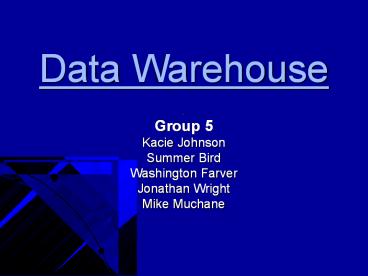Data Warehouse - PowerPoint PPT Presentation
Title:
Data Warehouse
Description:
Data Warehouse. Group 5 Kacie Johnson Summer Bird Washington Farver Jonathan Wright Mike Muchane – PowerPoint PPT presentation
Number of Views:274
Avg rating:3.0/5.0
Title: Data Warehouse
1
Data Warehouse
- .
- Group 5
- Kacie Johnson
- Summer Bird
- Washington Farver
- Jonathan Wright
- Mike Muchane
2
Outline
- I. Data warehouse definition and integrated
technologies - II. OLAP and OLTP
- III. The concept of data warehousing
- IV. How data warehouses are used by companies
- V. History of data warehousing
- VI. Advantages and Disadvantages
- VII. Future applications
3
Definition
- A data warehouse is a logical collection of
information gathered from many different
operational databases used to create business
intelligence that supports business analysis
activities and decision-making tasks.
4
Business Intelligence
- Business intelligence usually refers to the
information that is available for the enterprise
to make decisions on. A data warehousing (or data
mart) system is the backend, or the
infrastructural, component for achieving business
intelligence
5
Data Mart
- A database that has the same characteristics as a
data warehouse, but is usually smaller and is
focused on the data for one division or one
workgroup within an enterprise.
6
Data Mining Tools
- Data mining tools are Software tools used to
query information in a data warehouse. Consist
of
- Query-and-Reporting tools
- Intelligent Agents
- Multidimensional analysis tools (MDA)
- Statistical tools
7
OLAP
- A data warehouse uses OLAP (On-Line Analytical
Processing) to collect, organize, and make data
available for the purpose of analysis - to give
management the ability to access and analyze
information about its business. This type of data
can be called informational data.
8
OLTP
- Most data is collected to handle a company's
on-going business. This type of data can be
called "operational data". The systems used to
collect operational data are referred to as OLTP
(On-Line Transaction Processing).
9
Data Warehouse Is
- Subject Oriented
- Integrated
- Time Variant
- Nonvolatile Collection of Data for Managements
Decisions
10
Building Blocks
- Source Data
- Date Staging
- Data Storage
- Information Delivery
- Metadata
- Management and Control
11
(No Transcript)
12
Design of DW
- Integration facilitates an overview and analysis
in the data warehouse - Separation operations used for reporting,
decision support, analysis and controlling
13
Dimensions and Measures
- Dimensions categorizes each item in a data set
in non-overlapping regions. - Measures a property that can be summed or
averages using pre-computed aggregates.
14
Types of Data Warehouse
- Financial
- Insurance
- Human Resources
- Global
- Data Mining/Data Mining and Exploration
- Telecommunications
15
Before DW
- Executives and decision makers could get critical
information that already existed on the
organization - The available data was exceedingly difficult to
get (data in jail) - Only a fraction of the data captured, processed
and stored was actually available (data poor)
16
DW In Companies
- Validation where users validate what they
already believe to be true (45) - Tactical Reporting where the user uses the data
for tactical reasons (40) - Exploration where the user searches for
knowledge not already known (15)
17
Why the volume of data is exploding
- DWs carry historical data
- DWs carry detailed data
- DWs carry data for which there is no known need
- DWs carry eCommerce data
18
Advantages
- Cut costs
- Boost revenues
- Saves time
- Better customer service
- Avoids old data
- Queries or reports without impacting the
performance of the operational systems - Combines related data from separate sources
- Increased data consistency
- Improves access to a wide variety data
19
Disadvantages
- Can complicate business processes.
- Data warehousing can have a learning curve that
may be too long for impatient firms. - Can require a great deal of "maintenance.
- The cost to capture data, clean it up, and
deliver it . - Inability to adapt quickly to changing business
conditions or requirements.
20
Future Developments
- Development of parallel DB servers with improved
query engines will make it possible to access
huge data bases in much less time - Another new technology is data warehouses that
allow for the mixing of traditional numbers, text
and multi-media. The availability of improved
tools for data visualization (business
intelligence) will allow users to see things that
could never be seen before.
21
Any Questions?































